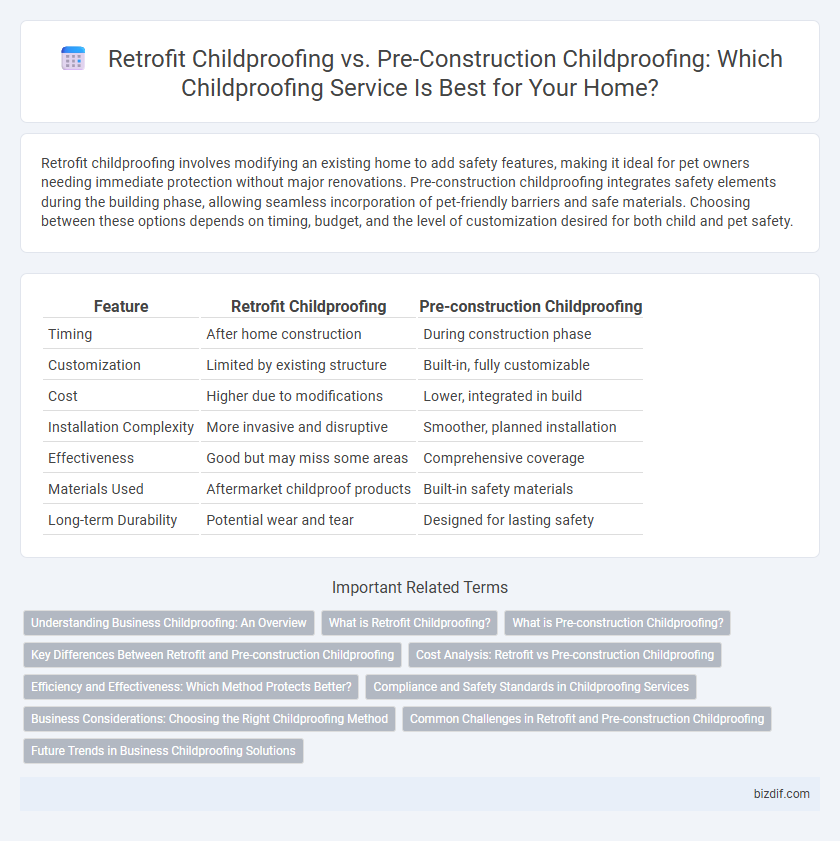Retrofit childproofing involves modifying an existing home to add safety features, making it ideal for pet owners needing immediate protection without major renovations. Pre-construction childproofing integrates safety elements during the building phase, allowing seamless incorporation of pet-friendly barriers and safe materials. Choosing between these options depends on timing, budget, and the level of customization desired for both child and pet safety.
Table of Comparison
| Feature | Retrofit Childproofing | Pre-construction Childproofing |
|---|---|---|
| Timing | After home construction | During construction phase |
| Customization | Limited by existing structure | Built-in, fully customizable |
| Cost | Higher due to modifications | Lower, integrated in build |
| Installation Complexity | More invasive and disruptive | Smoother, planned installation |
| Effectiveness | Good but may miss some areas | Comprehensive coverage |
| Materials Used | Aftermarket childproof products | Built-in safety materials |
| Long-term Durability | Potential wear and tear | Designed for lasting safety |
Understanding Business Childproofing: An Overview
Retrofit childproofing involves adapting existing structures with safety features like outlet covers, cabinet locks, and corner protectors to minimize hazards in operational business environments. Pre-construction childproofing integrates safety measures during the building phase, such as rounded edges, tamper-proof windows, and integrated safety gates, ensuring a safer space from the outset. Understanding these approaches helps businesses implement tailored solutions that comply with child safety regulations and enhance customer trust.
What is Retrofit Childproofing?
Retrofit childproofing refers to the process of installing safety features in an existing home to protect children from hazards. This service involves adding protective measures such as outlet covers, cabinet locks, stair gates, and window guards to already constructed spaces. Retrofit childproofing is essential for families moving into older homes or those wanting to upgrade safety in their current living environment.
What is Pre-construction Childproofing?
Pre-construction childproofing involves integrating safety features during the building phase before walls and fixtures are installed, allowing for seamless incorporation of protective elements like outlet covers, corner guards, and secure cabinetry. This proactive approach ensures a higher level of safety customization and reduces the need for modifications later on. By addressing potential hazards early, parents can enjoy peace of mind knowing their home is designed with child safety as a fundamental priority.
Key Differences Between Retrofit and Pre-construction Childproofing
Retrofitting childproofing involves installing safety features after a home is fully constructed, focusing on adapting existing structures to minimize hazards like sharp edges, exposed outlets, and unstable furniture. Pre-construction childproofing integrates safety measures during the building phase, enabling seamless incorporation of secure designs such as rounded corners, locked cabinets, and safe stair gates. Key differences include cost-effectiveness, customization flexibility, and the degree of structural modification required, with pre-construction offering more preventative safety integration and retrofit providing practical solutions for existing homes.
Cost Analysis: Retrofit vs Pre-construction Childproofing
Retrofit childproofing generally incurs higher costs due to the need to modify existing structures, often requiring labor-intensive adjustments and specialized materials to fit established designs. In contrast, pre-construction childproofing allows integration of safety features during initial building phases, reducing both material expenses and labor time significantly. Investing in pre-construction childproofing typically results in better budget allocation and long-term savings, optimizing overall child safety in homes.
Efficiency and Effectiveness: Which Method Protects Better?
Retrofit childproofing involves adding safety features to an existing home, offering quick implementation but sometimes facing challenges due to structural constraints. Pre-construction childproofing allows for integrated safety designs, ensuring optimal placement and durability of protective elements, making it inherently more effective. Efficiency-wise, pre-construction methods reduce long-term modifications, while retrofit solutions provide immediate protection in established environments.
Compliance and Safety Standards in Childproofing Services
Retrofit childproofing involves modifying existing structures to meet current safety standards, ensuring compliance with updated building codes and hazard prevention guidelines. Pre-construction childproofing integrates safety features during the building phase, allowing seamless adherence to regulations and reducing the risk of unsafe conditions. Both methods prioritize compliance with child safety standards, but pre-construction approaches often provide enhanced protection by embedding safety measures from the outset.
Business Considerations: Choosing the Right Childproofing Method
Retrofit childproofing prioritizes adapting existing structures with minimal disruption, often leading to higher labor costs and longer project timelines compared to pre-construction methods. Pre-construction childproofing offers seamless integration of safety features during the building phase, reducing retrofit expenses and ensuring compliance with evolving safety standards. Businesses must evaluate project scale, budget constraints, and timeline flexibility to determine the most cost-effective and efficient childproofing approach.
Common Challenges in Retrofit and Pre-construction Childproofing
Retrofit childproofing often faces challenges like limited access to structural elements, the need to work around existing finishes, and potential disruption to living spaces. Pre-construction childproofing allows integration of safety features during the building process but can encounter difficulties in predicting specific hazards and accommodating future changes. Both approaches require tailored solutions to ensure commonly missed risks such as sharp edges, electrical outlets, and window locks are effectively addressed.
Future Trends in Business Childproofing Solutions
Retrofit childproofing focuses on adapting existing business environments with customizable safety solutions, while pre-construction childproofing integrates safety features directly into the design phase, offering seamless and proactive protection. Future trends in business childproofing solutions emphasize smart technology integration, such as IoT devices for real-time monitoring and hazard detection, enhancing safety and compliance. Sustainable materials and modular safety components are gaining traction, allowing businesses to upgrade child safety measures efficiently as regulations evolve.
Retrofit Childproofing vs Pre-construction Childproofing Infographic

 bizdif.com
bizdif.com